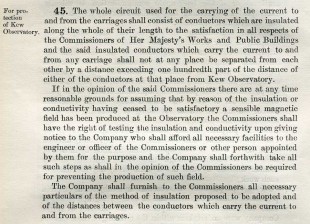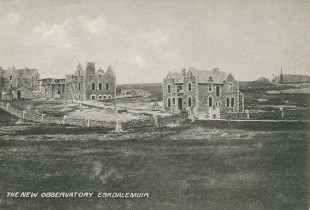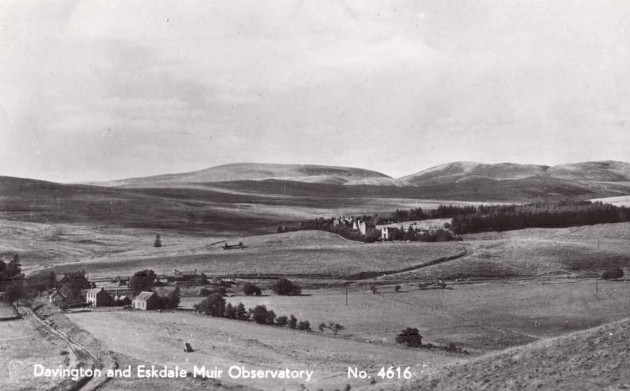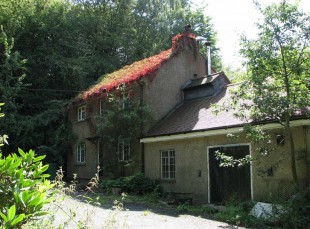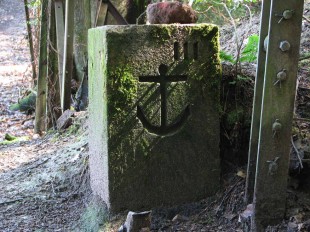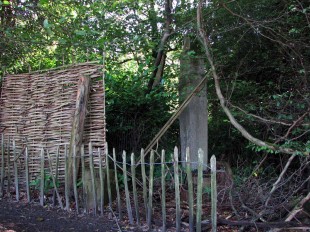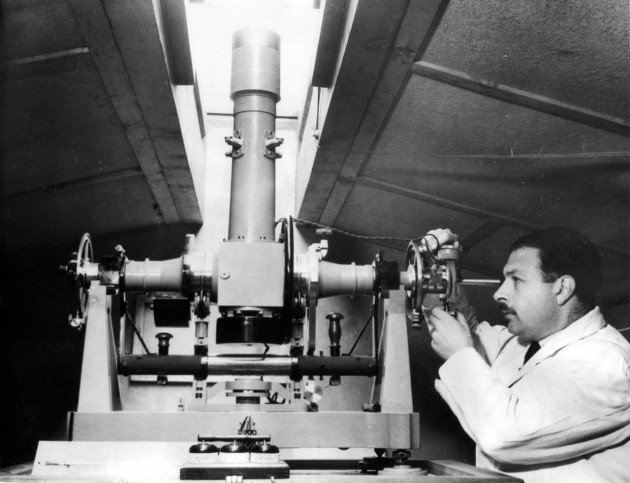…where east meets west
- Home
- Brief History
- The Greenwich Meridian
- Greenwich
(1675–1958) - Herstmonceux
(1948–1990) - Cambridge
(1990–1998) - Outstations (1822–1971)…
- – Chingford (1822–1924)
- – Deal
(1864–1927) - – Abinger
(1923–1957) - – Bristol & Bradford on Avon
(1939–1948) - – Bath
(1939–1949) - – Hartland
(1955–1967) - – Cape of Good Hope
(1959–1971)
- Administration…
- – Funding
- – Governance
- – Inventories
- – Pay
- – Regulations
- – Royal Warrants
- Contemporary Accounts
- People
- Publications
- Science
- Technology
- Telescopes
- Chronometers
- Clocks & Time
- Board of Longitude
- Libraries & Archives
- Visit
- Search
Abinger Magnetic Observatory (1923-1957)
Originally set up at Greenwich in 1817, the Magnetic Observatory moved to Abinger in Surrey in the early 1920s following proposals to electrify the railways in the Greenwich area. It was operational at Abinger from 1924 until 1957 when it moved to Hartland in Devon. During the war years, Abinger was also home to the Greenwich Time Service. The time service remained at Abinger until it moved to Herstmonceux in the 1950s.
Location of the Abinger site
The purpose of a magnetic observatory
The purpose of a magnetic observatory is to measure and record the changes that occur in the Earth’s magnetic field. These are of two types. The first, which includes the westward drift of magnetic north, arise because of what is happening within the Earth’s core. The second, were discovered in the nineteenth century, and arise mainly from currents in the ionosphere and magnetosphere as a result of phenomena occurring on the Sun. These changes take place over a much shorter timescale.
Magnetic observations at Greenwich and the beginnings of magnetic interference
Greenwich’s original interest in making magnetic observations stemmed from its founding remit to improve navigation at sea. The earliest measurements were made by John Flamsteed in 1680, but it wasn’t until 1817 that a purpose built magnetic observatory was erected. Made of wood and located towards the bottom of the steep slope to the west of the later Altazimuth Pavilion, the foundations gave way and in 1824 the instruments were removed and observations ceased.
A new building was erected by Airy in 1838 on the site now occupied by the Peter Harrison Planetarium. Observations restarted the following year. The erection in 1879 of the Naylor 6-inch equatorial (later lost at sea) some 35-feet south-south-east of the Deflexion instrument gave rise to concerns that it might cause interference. An exhaustive series of tests showed it did not, and observations continued undisturbed until Christie built the Lassell Dome in 1883. The new dome with its telescope contained copious amounts of iron, whose presence forced the relocation of both the dip and deflexion instruments. Other instruments became affected when construction of the South Building with its steel frame and electrical generators began in 1891. The building of the Altazimuth Pavilion in 1894-5 was to exacerbate the problem, forcing Christie to seek a new location for the magnetic observatory. It took until 1897 to find a suitable spot that was both magnetically neutral and still close at hand within the boundary of Greenwich Park (The Christie Enclosure).
Electrification of the railways and tramways
Meanwhile, back in December 1890, small uncountable agitations began to be detected in the Horizontal and Vertical Force traces. These corresponded to similar disturbances detected by the Earth Current registers. They started around 7 o’clock in the morning, ended around 11 o’clock at night, and were generally absent on Sundays. It took until the following summer for their source to be traced to the opening of the City and South London Railway (now part of the Northern Line) some 4¼ miles away. This was the first electric railway in London. It operated at 500V DC using an insulated third rail to deliver the current, with the return being via the uninsulated running rails. Four years in the making, the railway was officially opened by the Prince of Wales on 4 November, and opened to the public on 18 December.
Had the power delivery system been such that all the return current flowed along the rails back to the substation, the magnetic fields produced by the outward and return currents would have more or less cancelled each other out, limiting the disturbed area to the vicinity of the railway. However, the return rail was not insulated from the ground, and part of the return current leaked into the earth. Not only did this reduce the cancellation effect (thereby affecting the Observatory), but the leakage currents created their own, smaller, magnetic fields as well.
Although, at this distance, the interference with the magnetic registers was not considered severe, it was only a matter of time before proposals would be made to electrify the multiplicity of existing lines and tramways in London. The closer they ran to the Observatory, the greater the impact they were likely to have on the magnetic instruments and the value of the magnetic records.
By 1893, a clause had been agreed for insertion in future parliamentary railway or tramway bills authorising electrical power, in order to protect not only the Greenwich Observatory, but also the magnetic observatory at Kew (established in 1857) along with various other government scientific establishments in London. Amongst its provisions was the stipulation that ‘either insulated returns or uninsulated metallic returns of low resistance’ should be used. The clause was inserted in numerous bills, which in the case of Greenwich included any that related to a line that came within originally ten, but later five miles of the Observatory.
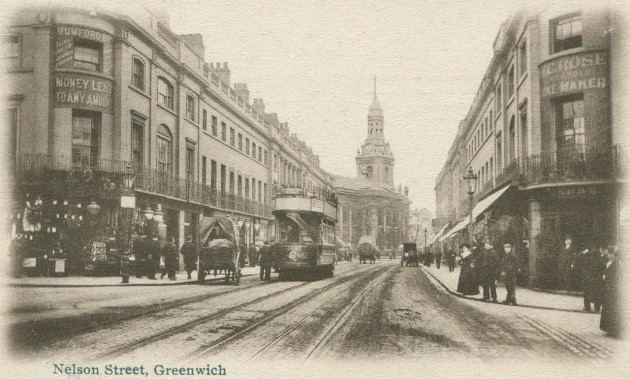
A tram in the centre of Greenwich in about 1904, shortly after the track had been electrified. The line ran less than half a mile from the Observatory. From postcard 651 published by Perkins, Son and Venimore (PS&V)
Problems at Kew – a warning bell for Greenwich
In 1898, the clause was included in a bill for the electrification of the lines run by London United Tramways near Kew. The means by which its stipulations were to be met was not specified and left (as was normal) for the company promoting the bill to decide. The system adopted on this occasion was for the return current to be carried by the steel running rails to which a copper bonding had been applied. The bonding proved inadequate and as the line neared completion in late 1900, its opening was indefinitely postponed pending a resolution to the ‘question of the protection to be given to the Observatory’. Rather than spend money on major modifications which may or may not have worked, London United followed a precedent already set in Berlin and offered to contribute towards the cost of the removal of the Kew instruments to a new location. At this point, recognising the difficulty of enforcing the legislation, together with the adverse effect that the Observatory protection clause was having on the development of trade and commerce, the Board of Trade instigated a dialogue with a view to legislating for the possible relocation of the Greenwich instruments as well. Christie’s considered view however was that with the electrification systems for the local tramways being proposed at that time by the London County Council and the South Eastern Metropolitan Tramways Company, the Greenwich Observatory and its unbroken sequence of magnetic measurements would probably be adequately protected and that any action regarding a possible relocation would be premature.A compensation deal of £10,000 was agreed to allow Kew to move to a new site at least 10 miles from potential magnetic disturbances. It is said the new location was found by moving a coin of suitable size around the map of the railway network until a clear space was found, remote both from railways and the possibility of future development. The closest reasonably accessible spot was close to the English boarder at Eskdalemuir in Scotland. On 19 July 1904 a ceremony took place to mark the start of building works. The new observatory opened in 1908 and is still operational today.
Electrification of the South Eastern and Chatham Railway and the decision to move
Meanwhile, back at Greenwich, a copper damper was successfully applied to the force magnet in 1902 which had the effect of reducing the vibratory disturbances from the railways. The following year, the South Eastern and Chatham Railway whose lines ran immediately to the north and south of the Observatory, obtained a Parliamentary Bill for the electrification of their lines. It contained the usual protective clause. At this point though, there was no particular scheme in mind and nothing much seems to have happened until 1913 when consideration was given to electrifying their suburban lines … which included of course, those that ran near Greenwich. The proposals came to nothing.
The First World War came and went and was followed by a rationalisation of the railways and with it a greater degree of standardisation. To this end the Ministry of Transport set up an ‘Electrification of Railways Advisory Committee’ chaired by Sir Alexander Kennedy. The outlook for Greenwich soon began to look bleak, so much so, that on 5 October 1921, a conference was convened at the request of the Admiralty to discuss the desirability & practicalities of relocating the magnetic observatory. It was attended by the Astronomer Royal and a number of senior officials from the Admiralty. Although there was an objection in principle to moving, (mainly on the grounds that the continuity of a valuable series of observations would be broken, and the difficulty of providing proper scientific supervision at a satellite location); the delegates bowed to the inevitable and concluded that the instruments should be moved and the railway company asked to bear both the rebuilding cost and the additional working expenses. A sum of £34,000 was suggested - £10,000 for the move and £24,000 for the additional running costs (20 years at £1,200 per year). These included the costs of employing an additional scientific assistant at £500 per year. Click here for a breakdown of the costs. When the Board of Visitors subsequently discussed the matter at a specially convened meeting on 1 December, they took the view that as the new site would be isolated, two additional assistants would be required and that the sum of £500 would be insufficient.
Criteria for the new site
A list of seven criteria that the new site had to meet was drawn up at the conference. They were that it should:
1. Be within 50 miles of London
2. Be near a village if possible
3. Be around 600 feet by 600 feet in size
4. Not be within 3 miles of a railway
5. Not be within 3 miles of any probable future railway
6. Consist of non magnetic material
7. Be easily accessible from Greenwich
The Admiralty immediately drew up a list of sites located three or more miles from a railway line. In order of their original ranking, these were:
Common land near Leith Hill in Surrey, Cudham, Chelsham, Leaves Green, Biggin Hill, South of Haslemere, Nutley. Ticehurst, Harrow, Benendon, Sutton Valence, Thursley, Great Munden, Brent Pelham, Bendish, Flanstead, Cholesbury, Milton Bryant, Cublington, Nettlebed, Hawthorn Hill, Little Berkhampstead, Norton Manville, And finally at just over 50 miles, Stelling.
Leith Hill was the definite front runner, the nearest sites to Greenwich (Cudham, Chelsham, Leaves Green and Biggin Hill) being vulnerable to extensions of electric tramways.
When it was put to the railway company that they should pay for the Observatory’s removal, they balked at the cost and stated that they could electrify the area around Greenwich in such a way that the Observatory’s instruments would be protected. Finally in 1923, the company (which by then was part of the newly formed Southern Railway), agreed to pay up. The final compensation paid, came to £37,145 5s. … considerably more than Kew had obtained, and far more than would have been got if Christie had not been so resolute all those years before.
Time though was of the essence: the new Observatory needed not only to be established before the electric trains started running, it needed to operate for a while in parallel with the one at Greenwich for calibration and comparative purposes.
A site at Abinger Bottom near Leith Hill, some 26 miles distant from Greenwich, was formally acquired in February 1924, (though access seems to have been gained from December 1923). Absolute observations began on 24 March 1924, with the site becoming fully operational on 1 April 1925. Meanwhile, back near Greenwich, the first electric trains began to run on 28 February 1926 with a full service from 6 June. At this point, all regular observations at Greenwich with the absolute magnetic instruments ceased.
The initial search at Holmbury St Mary
The detailed search for the new site began in about March 1923 when magnetic testing was carried out at five sites in the vicinity of the common land already identified near Leith Hill. i.e. to the centre of a triangle bounded by the North Downs line running in an east west direction to the north, the Mole Valley Line running in a north south direction to the east and the Cranleigh Line (closed in 1965) to the south. The central point of the triangle was a little over 3½ miles from each of the lines, and close to the village of Holmbury St Mary. Of the five sites, sites 1 and 2 were located on the common land (on the slopes of Holmbury Hill) and sites 3, 4 and 5 on farmland to the south.
Following a site visit by the Astronomer Royal in May, all were rejected in favour of a different site on the common about 300 yards to the west of site 1, and 2⅔miles from the nearest railway. The common land it was thought, would afford some degree of safeguarding against other buildings being erected in the vicinity that might cause magnetic interference. Initial soundings suggested the site could be procured relatively easily, and by compulsory purchase if necessary. In practice, no sooner had statutory notice of the Admiralty’s intent been published, than a very vocal campaign against the encroachment was orchestrated though the auspices of the press. One of the main protagonists was the Commons and Footpaths Preservation Society. To placate them, the Admiralty offered to buy an equivalent sized plot on the edge of the common to add back to it. The objection was withdrawn. But by then, the press frenzy, including an intervention from the pompous and woefully ill informed local Member of Parliament Sir Henry Buckingham had effectively put paid to the plans.
Acquisition of the Abinger site
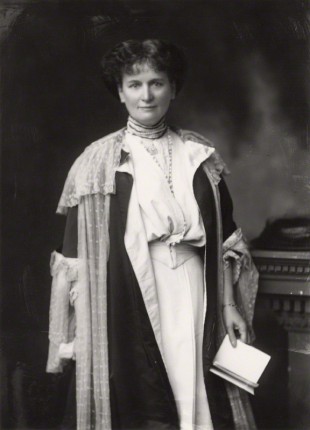
Flora (née Shaw), Lady Lugard. By George Charles Beresford. Half-plate glass negative, 1908. © National Portrait Gallery, London. Reproduced under a Creative Commons Attribution-NonCommercial-NoDerivs 3.0 Unported (CC BY-NC-ND 3.0) licence (see below)
Lugard was not the easiest of neighbours and a policy of appeasement was adopted so as not to provoke her. One such instance was when she requested the right to cut poles as mentioned above. Another arose as a result of a problem with the exhausts from the Observatory’s generators. This was rapidly dealt with, but. Lugard continued to complain of noise and vibrations from the site (which was over a ¼ mile away). In the light of legal threats and that the sale agreement had a covenant that made specific reference to ‘no offensive noisome or dangerous’ trade being carried out, a scientific investigation was instigated that involved both Lugard and other listeners. During an exhaustive series of tests, it was found that Lugard claimed to be able to hear the generators even when they weren’t running!
Development of the Abinger site
Located at Abinger Bottom, and 800 feet above sea level, the new site was wooded, roughly rectangular in shape, bounded on three of its four sides by public footpaths and just under 8 acres in extent. It sloped downwards towards the north-west and adjoined Sheephouse Lane at its south-eastern corner. Numbered boundary stones engraved with an Admiralty anchor were set up at each corner – the numbering going clockwise from Sheephouse Lane.
The first buildings to be erected were two dwelling houses, an office, a plant room and two magnetic buildings. The house for the caretaker was located by the site entrance on Sheephouse Lane. It was adjoined by an office room and building for the electric plant and accumulators. A house of superior quality for the resident observer (and costing nearly three times as much) was built to its west. The two magnetic buildings were similar to those then existing at Greenwich. They were located in an enclosure more or less at the centre of the site, and north of, and at a minimum distance of 370 feet from the power plant. With the exception of the magnetograph house, all the buildings were completed by the middle of August 1924. The resident mechanic who doubled up as the caretaker moved in on 25 August and the resident observer, Mr Stevens, on 1 September. They were joined by a second assistant Mr Finch who moved into lodgings on 8 December. It is worth pointing out here the changes in staffing levels that the move to Abinger necessitated. In June 1923, the Magnetic & Meteorological Department consisted of five members of staff (one established and four unestablished). By the following year it consisted of seven (four established and 3 unestablished) – so although the railway company were only paying for one additional member of staff, two had been employed as the Board of Visitors had earlier suggested.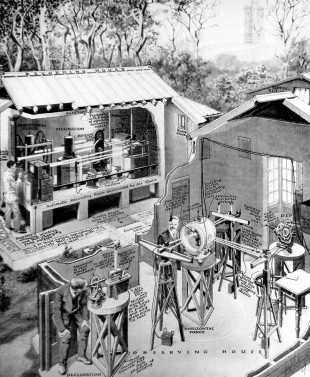
The Magnetic Pavilion (Observing House) with the Magnetograph House (Recording House) behind. The tower on Leith Hill can be seen in the background. From The Sphere, 1927
‘The Magnetic Pavilion for absolute observations is constructed of carefully chosen non-magnetic materials, and measures approximately 28 feet by 15 feet. It contains four circular tables stoutly built of hard wood into concrete piers which are free from contact with the floor. On the north pier is mounted the declination instrument, on the central pier the coil magnetometer for observing horizontal intensity, on the south-east pier the coil-magnetometer for observing vertical intensity, and on the south-west pier the dip inductor.
The Magnetograph House stands 50 feet east of the Magnetic Pavilion in which the absolute magnetic observations are made. The recording instruments are situated in an inner chamber 15 feet long, 12 feet wide, and 8 feet high. This chamber is supported on small concrete piers and is surrounded by an outer chamber, whose walls of non-conducting material are nearly 2 feet thick. Between the walls of the two chambers is an air space of from 2 to 3 feet. The inner chamber is electrically heated by about 50 suitably insulated low-temperature non-magnetic metallic resistance strips, each consuming 25 watts. The current used is alternating, and is therefore without effect upon the magnetic registration. The temperature of the Magnetograph House is controlled by a thermostat placed in the centre of the room, at the same level as the magnetic instruments. This actuates a relay, which switches the electric current into or out of the heating circuits. The departure from a mean temperature is not more than 0.2 ºC. The centres of the three instrument piers are situated as follows: For the horizontal force instrument, 2 feet west and 2 feet 6 inches south of the north-east angle of the room; for the declination instrument, 5 feet 6 inches west and 5 feet south of the same angle; for the vertical force instrument, 2 feet east and 3 feet north of the south-west angle. The two piers which support the recording mechanism occupy the north-west and south-east corners of the room, their longer sides being in the direction at right angles to the meridian. The clocks can be wound and the recording drums inserted or removed through shuttered openings in the wall of the inner chamber. The temperature in the chamber is read daily from a thermometer attached to the horizontal force instrument.’
A stunning set of 13 half-plate (120 x 165 mm) magic lantern slides showing the buildings and instruments at Abinger is held by Royal Museums Greenwich (Inventory ID: AST1119). They were made from photos taken by taken by William Moody Witchell (WMW), the Superintendent of the Magnetic and Meteorological Department and are most definitely worth viewing. Most, if not all of the images are thought to date from 1924 or early 1925. Images L8291-005 and L8291-008 show the caretaker’ house (with the adjoining wing containing the office and plant room) while it was still under construction. L8291-008 also shows the temporary rail track that was laid in order to deliver material to different parts of the site. L8291-005 shows the resident observer’s house under construction. L8291-009 and L8291-007 are two similar views of the two magnetic buildings (the former taken while construction was still under way and the latter soon after completion and following the erection of a boundary fence). L8291-010 and L8291-011 are internal views of the Magnetic Pavilion (Observing House) showing the layout of the instruments. L8291-004 is believed to be a view of the one of the two weight driven clocks used to drive the spools of photographic paper in the Magnetograph House. The remaining five images are detailed views of the instruments.
Two further pavilions were added later. The first, measuring 16 feet by 12 feet, was erected in 1926 for the testing and standardising of magnetic instruments (work formerly carried on at Kew Observatory). It was located about 40 feet south-east of the Magnetic Pavilion, and contained three concrete piers passing through the floor without contact.
The second, measuring, 20 feet in length and breadth, suitable for comparative observations and more convenient than the one erected in 1926 for standardising magnetic instruments, was completed in 1932. It occupied a position on the north-east of the pavilion for absolute observations corresponding to that of the testing pavilion on the south-east and contained three circular wooden tables built into concrete piers free from contact with the floor, similar to those in the Magnetic Pavilion.
Also in 1932, a concrete pillar, 10 feet in height, and distant 290 feet from the observing pier was erected to carry an azimuth mark for the observations of declination. Located in the extreme north east corner of the site, next to boundary stone 4 and the public footpath; the pier (but not the mark) still survives.
Apart from routine maintenance work, the only other modifications that seem to have been made to the magnetic buildings was their connection to the electric mains – a process that was initiated in 1934, together with the erection of a small wooden housing for the 50-volt battery used in coil magnetometer observations that was put up in 1936/7.
War time evacuation of the Greenwich Time Service
Although no further magnetic buildings were planned or built, development of the Abinger site did not stop. With the prospects of war looking ever more likely Abinger was reasonably well positioned for the setting up of a duplicate time station to take over from Greenwich should the need arise. A pier for a small transit instrument (for time determination) was constructed in the magnetic enclosure in 1938/9 and a wooden housing for it in 1939/40. Special care was taken in the design to secure adequate ventilation and to avoid stratification of the air. A portion of the old battery room was divided off by insulated plaster board for use as a clock room in which thermostatically controlled electric heating was installed. The former engine room was divided off by glazed partitions and block flooring laid. By June 1940, the setting up of the duplicate time service was almost complete.
But although Abinger was located at a relatively safe distance from London, the time service was still vulnerable because the Post Office (telephone) lines from Abinger and Greenwich though which the time signals were disseminated, both passed through the same exchange at St. Mary-le-Grand in London. With possible damage to the exchange in mind, a second reserve station was set up at the Royal Observatory in Edinburgh.
The determination of time and the transmission of time signals from Greenwich continued until the start of the Blitz in September 1940. At this point, the all-night air raids made night observing impossible and Abinger took over the determination of time. The Time Department together with the Meridian Department, the Astronomer Royal (Spencer Jones) and his office were all evacuated to the vicinity shortly after. Despite this, the time signals continued to be generated at Greenwich until November at which point this role too was transferred to Abinger.
Throughout the war years, the Abinger station was referred to as Station A and the Edinburgh one as Station B. After the war, Station B was shut down and a replacement reserve service set up at Greenwich.
The requisitioning of Cornerways and the renting of Feldemore
One of the main difficulties to arise from the increased number of staff was the provision of suitable housing. This wasn’t a new problem at Abinger. Back in 1925, Dyson’s request to the Admiralty for the building of a second Observer’s house due to the shortage of suitable houses for rent in the vicinity had been turned down – a shortage that was caused in part by the number of weekend homes in the area. But it wasn’t just housing that was needed now. So too was office accommodation.
Initially staff were compulsorily billeted with local residents, but in time some found houses of their own. Once it had been decided that the Astronomer Royal would be evacuated too, a substantial 1920s house called Cornerways at the junction of Hoe Lane and Horsham Road was requisitioned to provide both office accommodation and somewhere for him to live. By road, it was about three miles from the magnetic observatory.
Following the Astronomer Royal’s return to Greenwich in October 1945, Cornerways was used as a staff hostel for single staff. It also served as a staff canteen at lunchtime. Cornerways was given up at the end of 1948, and the hostel transferred to a larger and closer house near Holmbury St Mary that had been previously requisitioned for the Army. Known as Feldemore, it was built in the late 19th century as the country seat of Edwin Waterhouse (a founding partner of the accountancy practice of Price Waterhouse) to the designs of George Redmayne to plans of Alfred Waterhouse. The house provided some office and storage accommodation for the Time Department and accommodation for seven married members of the staff. When the hostel closed on 13 February 1955, some of the rooms set free were put into temporary use as a flat: the remaining rooms being used for stores and other official purposes.
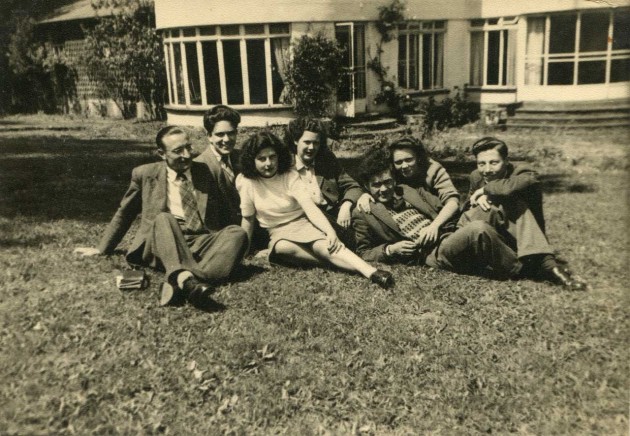
Cornerways c.1948. From left to right: 1.Fred Everest; 2.Pat Hogan; 3.Monica Lawrence; 4.Pamela Morris; 5.Henry Gill; 6.Rosemary Pavey; 7.John Ellenger. Everest and Lawrence later got married as did Gill and Pavey. Photo courtesy of Monica Everest
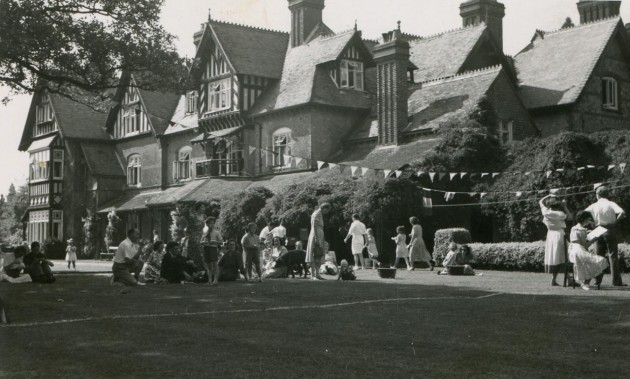
Staff and guests attending the annual garden party at Feldemore, c.1950. Photo courtesy of Monica Everest
New buildings for an improved Time Service
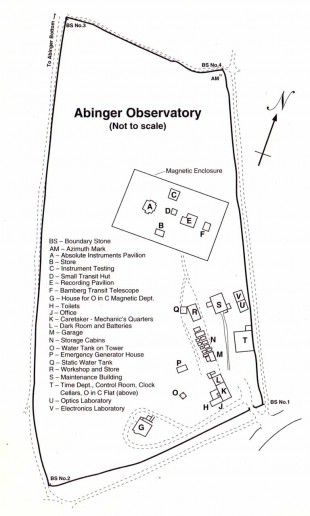
Post war plan of the Abinger site. The Shortt and Dent clocks of the Time Service were housed initially at location L and from 1942 until about 1950 in the specially constructed building marked S. S also housed the quartz clocks until a later new building T containing the clock cellars became available towards the end of 1944. Image courtesy of Peter Tarplee
But not only had the start of the War brought this work to an abrupt halt, the new facilities at Abinger had been set up in a hurry and were not altogether satisfactory. The clock room in particular was too small and cramped – so much so that there was serious mutual interference between the clocks, leading to inconsistencies in their timekeeping. In 1941/2 steps were put in place not only to improve these conditions, but also to restart the work with the quartz clock. A new building was erected with a minimum of expense and labour to provide suitable and adequate housing for three Shortt free-pendulum clocks and the quartz clock. It consisted of two separate clock chambers, inside a main brick and concrete room, approximately 25 square feet in area. The outer room was heated by hot-water radiators, the clock chambers being electrically heated, with thermostatic control. The first of the Shortt clocks (nos. 40 & 49) were installed in November 1942 and the third (no. 66) in December. The quartz clock was installed in January 1943. The slave clocks and ancillary equipment were installed in the outer room. This was the first of a cluster of buildings that ultimately developed for the time service near the entrance to the Abinger site.
The next building to be erected for the time service however, was in the magnetic enclosure. This was in 1942/3, when a new observing hut was erected to house a second instrument for time determination – the Bamberg Broken Transit, an instrument which was had been specially borrowed from the Astronomer Royal for Scotland. The new hut was in line with the Magnetic Pavilion and magnetograph house and stood to their east. Its footprint was 11 feet by 14 feet.
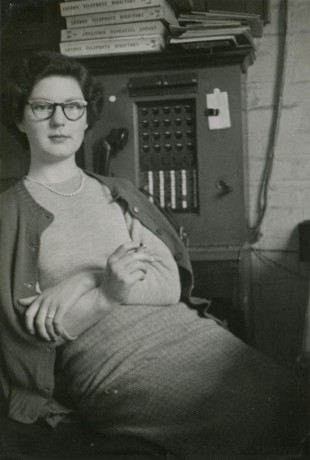
Monica Lawrence at the telephone switchboard in the general office of the Time Department, 1 March 1952. The Time Department had two phone lines: Abinger 360 and Abinger 361. Photo courtesy of Monica Everest
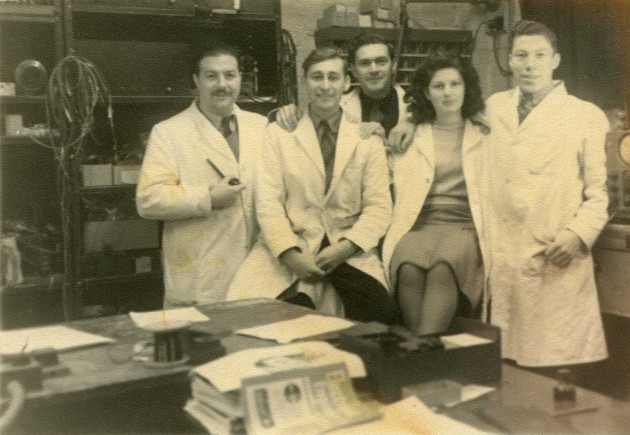
The Electronics Laboratory c.1949. From left to right: Vinicio Barocas; Joe Bates; Henry Gill; Monica Everest; John Ellenger (known as Junior). Photo courtesy of Monica Everest
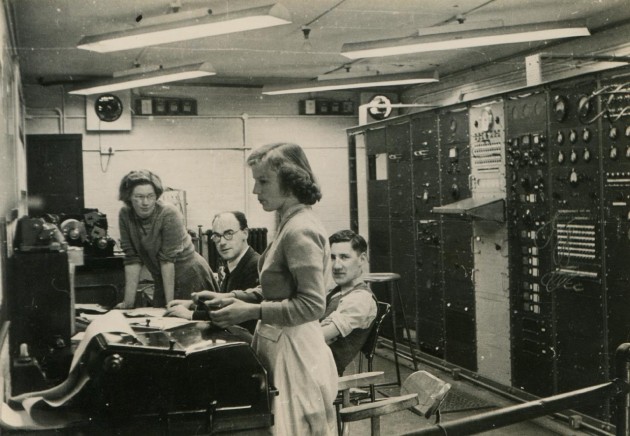
The Time Department Control Room. The teleprinter is in the bottom left-hand corner. The clock cellars were located beneath the Control Room. From left to right the individuals are: Irene Manning; Nathy O'Hora; Joan Phillips (who later married Pete Lamb) and Eric Shepherd. Photo courtesy of Monica Everest
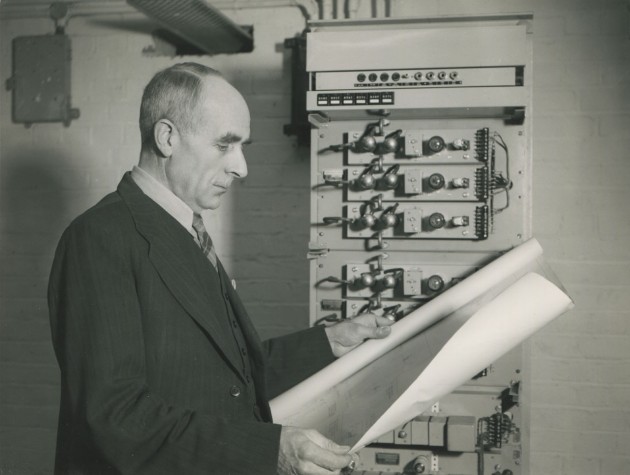
The Astronomer Royal, Harold Spencer Jones, in front of the monitoring panel for the group of 12 quartz clocks in 1945. The clocks became operational in 1946
With the decision taken in 1946 to move the astronomical observatory together with the Time Department to a new home at Herstmonceux, thoughts turned to the development of the Time Department’s facilities there rather than at Abinger. Routine maintenance and upgrading did however continue. In brief: in 1945/6, a Nissen hut to serve as a temporary workshop for the Time Department, and a temporary garage for Service vehicles were erected. In 1946/7 The rooms originally used to house batteries and engines and subsequently for time service equipment, were converted for use as dark rooms. The fittings, including wet and dry benches, were designed by the Admiralty Photographic and Instrument Research Laboratory and were made by the Construction Department, H. M. Dockyard, Chatham. Changes were also made to the electrical equipment and supply. A new cable was laid across the courtyard between the diesel-generator house and the main switchboard. In 1947/8 fluorescent lighting was installed throughout the offices, laboratories, workshop and control room and the lavatory facilities extended. The last building to be put up at Abinger appears to have been in 1950/51, when a new generator house was erected to house the emergency power supply equipment.
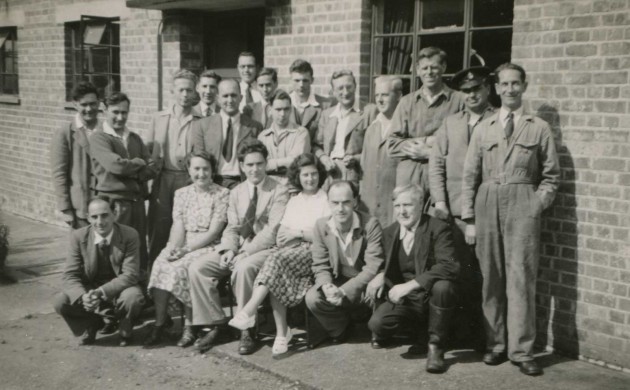
The staff of the Time Department outside their building at Abinger on Wednesday 2 August 1950. Humphry Smith (Head of Department and absent from the photo) had a flat on the top floor. His office was to the right of the door. The General Office was to the left. Front row, from left to right: 1.Roy H Tucker (known as Tommy); 2.Betty Tucker (née Collett); 3.Patrick Hogan; 4.Monica Lawrence; 5.Nathy O'Hora; 6.Paddy Hogan (Caretaker and father of Patrick). Back two rows, from left to right: 1.Henry Gill; 2.Lesley Bates (known as Joe); 3.Pete Lamb; 4.Eric Shepherd; 5.Johnny Rudd; 6.Arthur Cordwell; 7.Peter Willmoth; 8.Gerry Gaughan; 9.John Pope; 10.Fred Everest; 11.George Pitchford (Foreman of the Workshop); 12.Lofty Duffell (driver); 13.Jack Hutchins (driver); 14.Jack Challis (labourer). Photo courtesy of Monica Everest
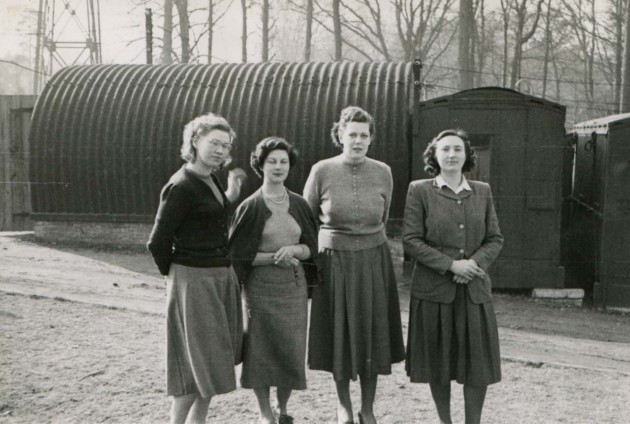
A water tank stood at the top of the tower on the left. The building seen side on was used as a garage and the others for storage. From left to right: Irene Manning; Monica Lawrence; Pamela Morris; Betty Tucker. 1 March 1952. Photo courtesy of Monica Everest
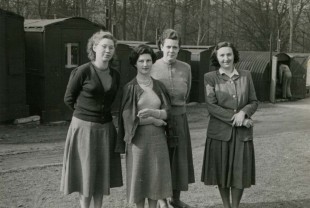
In this view, the camera has been panned to the right, showing more of the storage cabins. Photo courtesy of Monica Everest
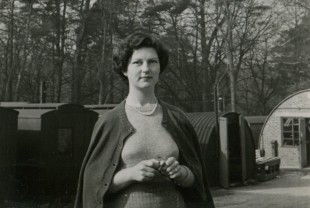
The camera has been panned further to the right, bringing the workshop into view. Photo courtesy of Monica Everest
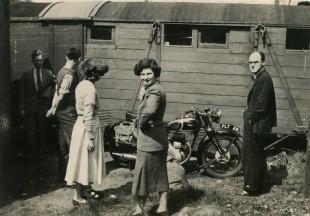
Fred Everest's motor bike in front of his Stores Office. From left to right: Pete Lamb; Eric Shepherd; Joan Phillips; Monica Lawrence; Nathy O'Hora. Photo courtesy of Monica Everest
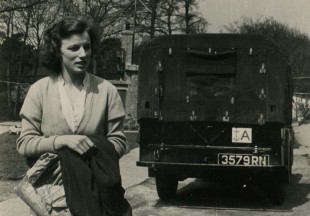
Joan Phillips and Tilly the Utility Vehicle. Jack Hutchins drove it to Dorking every day to pick up any necessities, including cream buns for the hungry staff – the staff canteen on site didn't provide such luxuries! Note the number plate and the Admiralty anchor on the vehicle's rear. Photo courtesy of Monica Everest
Monica Everest writes:
‘We certainly lived rough in those days, the whole site was so ramshackle and basic, it would never be accepted today, but to us all, it was ‘home’. We had a Canteen round the back behind the Nissen hut garage, yet another railway container where we bought cheese/meat paste and jam sandwiches, and had a choice of tea, coffee or soft drinks, served by Paddy Hogan’s wife, the formidable Mrs Hogan.’
Magnetic contamination and the move to Hartland
The criteria used when selecting the Abinger site contained stipulations about distance from London and accessibility from Greenwich. They were included partly in light of what had happened at the new Eskdalemuir Observatory, where opportunities for the necessary discussion and interaction with other experts in the field was distinctly limited; and partly by the desire to have the site under the full operational control of Greenwich.
Abinger though, was never a magnetically ‘clean’ site. Within months of it becoming fully operational, a regular service of electrified trains were running within 5 miles of the instruments on the Dorking to Waterloo line. The Mole Valley Line which passed 2¾ miles to the east was electrified in 1938, bringing with it an increase in magnetic interference. By the following year the Astronomer Royal was actively seeking to move the Observatory again. A special meeting of the Board of Visitors was convened in the rooms of the Royal Society in June 1939, to discuss not only the removal of the magnetic observatory from Abinger but also the Astronomical Observatory at Greenwich. Initial soundings had suggested that a location with good conditions for both magnetic and astronomical observations simply did not exist and that the two parts of the observatory would need to be moved to different locations. In the case of the magnetic observatory, it was agreed that further investigations into their suitability should take place at both Lynton and Hartland Point in Devon – both at a distance of at least 10 miles from a railway. The war intervened and it took until 1957 for the move to take place, to the chosen location of Hartland.
In a memorandum compiled for the Visitors in 1938 Spencer Jones was rightly critical of the decison taken in the 1920s to move the Observatory to Abinger, writing:
‘The policy adopted in 1923 of choosing a new site that should be readily accessible from Greenwich, in order to facilitate administration and supervision of the magnetic work, is now seen to have been unwise. But the rapid development of the electrification of the Southern Railway systems had not been anticipated.’ (ADM190/17).
This was particularly pertinent, as unlike Greenwich, the Abinger site was not protected by act of parliament. The only recorded suggestion for a site more than 50 miles from Greenwich came from HH Turner, former First Assistant and Savilian Professor of Astronomy and member of the Board of Visitors. In a private letter to the Astronomer Royal dated 26 November 1921, he made the suggestion of possibly moving it to Oxford or Cambridge and combining it with a building for seismology – a suggestion that was politely rebuffed. That the criteria for the site’s selection were endorsed by the Visitors can be put down at least in part to their limited experience of non-scientific matters – a direct result of the cliquey way in which the Board was constituted. It was not the first time such a failure of governance had occurred when the future of the Royal Observatory was being considered – nor would it be the last.
The buildings and Abinger Estate today
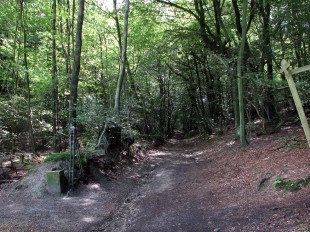
Looking south along the public footpath on the western boundary in 2011. Boundary stone III can be seen in the bottom corner
The Abinger magnetic observations
Complete copies of all the Abinger Data have been republished by the British Geological Survey and can be downloaded via the link below.
1926-1957, Abinger Magnetic data
Further reading & other links
Spencer Jones, H. Removal of Greenwich Magnetic Observatory into Surrey. The Observatory, Vol. 46, p. 314-315 (1923)
Smith, Humphry. Quartz Clocks of the Greenwich Time Service
Tarplee, Peter. Abinger and the Royal Greenwich Observatory: The Recording of Magnetism and Time. Guildford: Surrey Industrial History Group, 1996.
Acknowledgements
Special thanks are due to Monica Everest (née Lawrence) for providing so many of the images on this page and helping with the captions. Thanks also to Peter Tarplee for his permission to reproduce the plan of the Abinger site.
Flora (née Shaw), Lady Lugard. By George Charles Beresford. Half-plate glass negative, 1908. © National Portrait Gallery, London. Reproduced under a Creative Commons Attribution-NonCommercial-NoDerivs 3.0 Unported (CC BY-NC-ND 3.0) licence. National Portrait Gallery Object ID: NPG x6539.
© 2014 – 2025 Graham Dolan
Except where indicated, all text and images are the copyright of Graham Dolan
